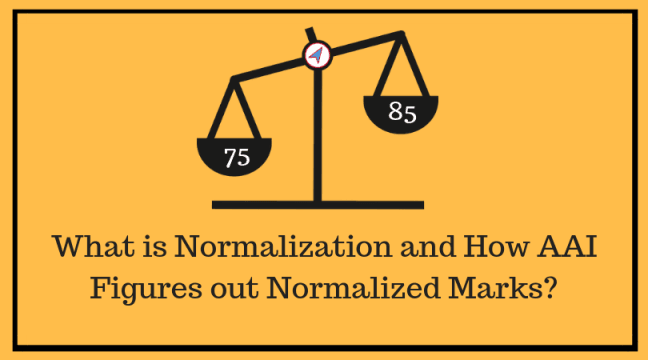Normalization is the process of adjusting values measured on different scales to an imaginary common scale. If I talk in terms of an exam then Normalization is the process of adjusting marks obtained by students in a shift to a notionally common score.

Bringing marks to a common level considering different difficulty levels across different shifts/slots of an exam is called Normalization and marks after adjustment are called Normalized Marks.
Role of Normalization in Exam
It was all good till all students were getting the same question paper in an exam. But the scenario now is different. Because of the increasing number of students, exams now are being conducted in multiple shifts/slots and each shift has a different question paper. For example, AAI recently conducted ATC exam in 3 shifts i.e. Morning, Afternoon, and Evening Shifts. So there are chances that questions in one shift can be tougher than in other shifts. In other words, the difficulty level of a question paper in one shift can be different from another. So students who get easy question papers might score higher than the students in other shifts with difficult question papers. In fact, this can be easily noticed by looking at the average score and total score in a particular shift. The average score and total score will be higher in shift with an easy question paper.
One can’t just say I was unlucky I got a difficult question paper. There must be something to ensure that each and every student across all the shifts in an exam should get a question paper with the same difficulty level. So ‘Normalization of Marks’ is something which was introduced to remove this discrepancy in exams. To make the game fair, Normalization of marks is done for all candidates who write the exam a particular post across all shifts. Usually, the marks of students in shift with difficult question papers are increased proportionally to match with other shifts in terms of difficulty level.
Normalization Method Used by AAI
Airports Authority of India uses a different formula for normalization than other Exam conducting bodies like RRB, SSC, etc. The purpose however is the same. In order to apply the normalization formula, AAI looks for the following 2 things –
- The average score for each Shift
Xav = total marks scored by candidates in a shift divided by no. of candidates in the shift. - Standard Deviation of the score for each Shift.
N = Number of candidates
X = Raw score of candidates
L = Total Raw score for all candidates in a shift
Xav = Average which is the total marks divided by no. of candidates.
x = Raw Score of Candidate – Simple Average (X-Xav)
Standard Deviation (S) = (Σ x²)/N
Normalization Formula used by AAI
Now have a look at the formula for how AAI figures out the normalized score of a candidate. A shift with the highest average of raw scores is generally taken as the base for normalization.
Normalized Score for each candidate (Xn) = Xn = (S2 / S1) * (X – Xav) + Yav
Where
- S2 is the Standard Deviation of the shift with the Highest Average Score (taken as Base for normalization)
- S1 is the Standard Deviation for the corresponding shift (to be scaled to S2)
- X is the Raw score(actual score) of a candidate
- Xav is the Simple average of the Shift
- Yav is the Average corresponding to the shift with the highest Average
Let’s understand this by an example
Suppose the exam was conducted in 2 shifts: M (Morning) and E (Evening)
Assume that the total candidates in M and E shifts are 5 (A, B, C, D, and E) and 4 (K, L, N, and P) respectively, although, in the actual scenario, the number of candidates is in thousands. Candidates in each shift scored the following marks:
Morning Shift: – A: 75, B: 80, C: 85, D: 65,E: 70
Evening Shift: – K: 75, L : 80, N : 90, P: 95
Average score of M shift= (75+8+85+65+70)/5= 375/5 = 75 (Difficulty level = High)
Average score of E shift= 340/4= 85 (Difficulty level = Low)
Based on the average score, we can derive that the difficulty level of questions in the Morning shift is High. Normalization will be done w.r.t. Evening shift marks.
Standard Deviation of M shift(Sm): (0+25+100+100+25)/5 = 50, [as SD = (Σ x²)/N]
Similarly SD of Evening shift(Se)= (100+25+25+100)/4= 62.5
Normalized Score for each candidate (Xn) = (Se / Sm) * (X – Xav) + Yav
Normalized Marks:
Normalized Marks of A: (62.5/50)*(75-75)+85=85 (Actual marks scored were: 75)
Normalized Marks of B: (62.5/50)*(80-75)+85=91.25 (Actual marks scored were: 80)
Normalised Marks of C: (62.5/50)*(85-75)+85=97.5 (Actual marks scored were: 85)
Normalised Marks of D: (62.5/50)*(65-75)+85=72.5 (Actual marks scored were: 65)
Normalized Marks of E: (62.5/50)*(70-75)+85=78.75 (Actual marks scored were: 70)
From the example above, You can see that 75 marks in the Morning shift are equivalent to 85 marks in the Evening shift. The selection of low-scoring students in tough shifts instead of little high-scoring students in easy shifts thus makes complete sense. Selection lists are prepared based on normalized scores instead of original scores. Hope you now understand the concept of normalization and how normalized marks are figured out.

Sir, what could be the expected cutoffs this year for final selection? Also please guide on how to prepare for voice test.